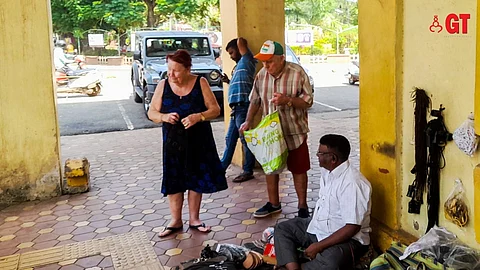

After strolling around the city, Sue and Harvey return to the cobbler to pick up the shoes they had left behind to be mended. After checking them, they ask the cobbler how much they owe him. “Rs 350,” he mutters.
Harvey takes out a Rs 500 note and thrusts it in the cobbler’s hand and Sue follows by adding another Rs 200. The smile on the cobbler’s face grows wide.
“People here are very nice. We would have been fleeced in any other State of India, but not here. The job is well done, in time, the pricing reasonable and now we have time to go and sit for a few beers,” says Harvey, as his partner indicates she wants to roam around the market.
Goa is special to many tourists. Most holiday stories are reflected in the interaction between the couple from England and the cobbler from Goa. It is the element of trust and dependency that distinguishes Goa as a repeat destination.
Roaming along the garden in Margao, Lorenzo from Italy, who has switched from north to south, knows more places in the city than many locals living in the north would.
Roaming along the garden in Margao, Lorenzo from Italy, who has switched from north to south, knows more places in the city than many locals living in the north would.
“The South is quieter and the people are not as aggressive. They are always ready to help. There are times when I get a lift to the city and there are people in the market who know exactly what I am coming for. It is shanti (peaceful) here,” he says as he sips from his can of beer.
Lorenzo knows where to get the best foreign exchange rates in the market, which lady has the freshest vegetables to sell and even where the best brooms can be purchased from.
“Goan rice is not heavy for the stomach, and my wife prefers to use black jaggery to prepare sweets,” he admits as he sits in the garden enjoying his drink. “I normally have lunch and return to my apartment,” he mutters as it starts getting hotter.
Though the tourists are there, the drop in charter tourists is visible.
“There is no doubt that tourists are coming, but they are trickling in. There was a time when there used to be ten charters or more reaching Goa every week. We have just two or three now and that is not enough,” says Sergio, owner of a restaurant on the beach in South Goa.
“Tourism, like everything, sells best through word of mouth, and most tourists have returned with good memories of this place. So, I wonder whether the slow rate of arrivals is because of the economic pinch after the pandemic,” Sergio says.
Yet, activities on beaches in South Goa are on an ascendance, especially the playing of music. The genre of music changes, from jazz to Bollywood or retro every 100 metres, depending on the clientele.
It is around 9 pm and a people are walking along the shore, some wading in the water, some enjoying the music and others simply taking in the late-night experience of the beach.
“This is a strange experience for us. Being able to walk on the beach so late, and seeing so many people around at this time is amazing. The best thing is it feels safe,” says Shruti, getting a first-time experience of a night walk with her mom.
Homestays have started opening up with the return of guests. “Normally most guests arrive around this time of the year and hang around till March or April,” reveals Brian who runs a homestay.
With November nearly over and the month known as the peak of the season hovering around the corner, stakeholders live in the hope that the good times will flow faster.